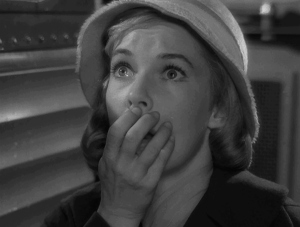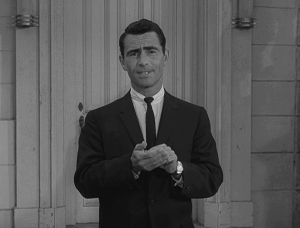Blog Archives
After the Zone-a-thon II
Henry Bemis and his all-too-breakable eyeglasses? Check. Talky Tina? She was there. Agnes Moorehead, battling two tiny aliens who crash-land on her roof? Front and center. A gremlin on an airplane wing? He flew in just for the occasion.
Yes, the roster of fifth-dimension All-Stars was long at the Syfy channel’s annual two-day Twilight Zone marathon this New Year’s. From the tension-filled houses on Maple Street to the lush cornfields of Peaksville, Ohio, hardly anyone missed the festivities.
But although the schedule was packed with fan favorites, a few gems were conspicuously absent. We all would have been better served if replacements for clunkers such as “What’s in the Box” and “Caesar and Me” had been pulled from the following list:
Season 1, Episode 21 – February 26, 1960
Parallel planes. Disappearing doppelgängers. It’s a metaphysical mind-trip of the first order, one that definitely deserved a spot on Syfy’s schedule. I’m blaming Vera Miles’s wily twin for making this classic vanish from the marathon. Read the rest of this entry
A True “Death” Match
What could be more dramatic than a fight to the death? Unless it’s a fight WITH death. That’s something you seldom see outside of Sandman comics and Ingmar Bergman films.
Or The Twilight Zone.
But how about if we make the stakes even higher? How about a battle BETWEEN deaths? Specifically, between the “Mr. Death” played by Murray Hamilton in “One for the Angels” and the one portrayed by Robert Redford in “Nothing in the Dark”.
In a moment, I’ll ask you to vote between them. But before you scroll down and pick Redford because you think he’s handsome, or Hamilton because “One for the Angels” is your favorite episode, let’s pause to review their qualifications. Read the rest of this entry
The Write Stuff
“This is a series for the storyteller, because it’s our thinking that an audience will always sit still, and listen [to], and watch a well-told story.”
That quote by Rod Serling is from a short film made in 1959 to interest potential sponsors in buying ad time on a brand-new series called The Twilight Zone. It’s a telling remark — one that, I believe, offers a key insight into why the show succeeded, even beyond Serling’s expectations. It helps us understand why the show still appeals more than 50 years later.
In short, Serling had the formula correct from the start: tell a good story.
Think of an episode like a wheel. There is acting, directing, music, special effects. All of those elements are important, but they’re like the spokes of the wheel. They won’t work unless they’re attached firmly to something strong and well-structured: a hub. Read the rest of this entry





